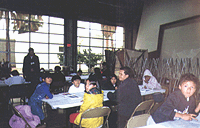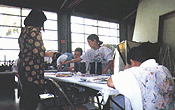Leo F. Hobaica, Jr. relates his winning experience as faculty coordinator of CalArts Community Arts Partnership animation workshops, which teach animation fundamentals to children.

I am one of those fortunate people who have a job that is a win/win situation. In fact, it is a component that is designed into the most fundamental architecture of my job. I actually know of no one who is not "winning" in our Community Arts Partnership (CAP) animation workshops at Inner-City Arts in downtown Los Angeles.
By way of introduction, my commitment to the classroom has a 30-plus year history. I have taught at all levels within the system, from pre-school, through elementary settings, high school to the graduate seminar. In all of those years and situations, this particular program is worth a bit more scrutiny and praise. In my estimation, the CAP/Inner-City Arts project has a solid rightness that is unarguable.
The California Institute of the Arts (CalArts) Community Arts Partnership (CAP) connects off-campus arts educational sites with the discourse that happens on campus. Spearheaded by the very capable and nourishing guidance of Glenna Avila, interested CalArts students elect to be the hands-on teachers at various partner sites in Los Angeles. Driven by a leaning toward the possibility of teaching as a career, the love of their artistic discipline, the desire to share and the need for spare pocket change, these students, from all disciplines in the arts, have been able to get their students to produce some vibrant completed projects.

Elementary Animation
Twice a week at Inner-City Arts in Los Angeles, for example, a van from CalArts arrives with the teaching students, 30 minutes before the younger students. Bundled in their distended satchels are animated films to be shown, lesson plans from the "master teacher" for that particular day, audio-visual aids to help further the presentation for the exercises taught, etc. In other words, all the things that a trained professional educator would have in place. This particular animation curriculum is designed for the 5th and 6th grade classes that we work with from the Los Angeles Unified School District though Inner-City Arts. The CalArts students, culled from both the Character Animation and Experimental Animation programs at the Institute, demonstrate how to make a zoetrope strip, morphing, flip books, draw on film, story-board, cut-out puppetry, backgrounds and even use the "LunchBox" for capturing motion. By the end of the 12-week semester, the group of 30 will have collaboratively produced a 3 to 5-minute animated piece with characters, backdrops and story line. A personal copy of the videotape will be taken home to mom and dad as well.
Graduation from the workshop is an equally wonderful experience for all of us. Usually held in a public setting within their school, and with an invited audience from other classes, as well as their proud moms and dads and principals, each young graduate is called to the podium, handed a certificate, given a copy of the film, a T-shirt and a hug or handshake from one of us. Then the lights go out, the projector switch is hit, and the premier begins.

Serious Instruction Saturdays are devoted to students in grades 9-12, and a few who are presently in junior colleges. We use the ubiquitous CalArts vans yet again to pick-up participants at three of the high schools in the downtown area of the city. This semester, 18 new students have signed up for the free classes. Many of the initial exercises are modeled after the grade school curriculum, but are adjusted for these older minds. Here, the flipbook is quickly replaced with traditional, punched animation paper and animation bars. The portable LunchBox easily records more essential motion than either a flipbook or zoetrope strip can provide.
The blank sketchpad that is handed out at the first session encourages the adolescent group to keep an ongoing visual diary of their week, at home, school and en route. Their group project amounts to an "exquisite corpse" exercise, about six seconds of animation per person, that cements a fundamental experience and understanding of some of the basic principles of traditional hand animation. Students who have been in the Saturday workshop for more than a year are encouraged to work on independent, self-initiated projects, supported by a more intimate ratio of teachers to students. In all instances, expectations are high for completed, crafted and thought-out works.
At the end of a full year of the program, a warm graduation event occurs at Inner-City Arts, peopled with family and friends of these young and enthusiastic filmmakers. The focus and responsibility of a premier gives credibility to their work and a sense of pride for the accomplishments they have earned through their efforts.

In the end, it is easy to track all of the winning that I spoke of earlier. Beaming faces are usually the most obvious indicators. They are seen on the faces of the contented filmmakers, proud family and friends, tired yet satisfied young teachers, staff from Inner-City Arts and CAP signing blank jackets on the duplicated video cartridges and me, knowing that this is one of the best things that is going on in this town.
Read about other workshops focused on children in the following Animation World Magazine articles: "Folk Animation: Low Tech Art in the High Tech Age," "Kids Making Animation: Children's Animation Workshops Around the World" and "Yvonne Andersen: Profile of a Pioneer."
Leo F. Hobaica, Jr., Associate Director, Character Animation at CalArts, completed a B.A. in Literature, Philosophy, and Religion; and received an M.F.A. in Fiber/Mixed-Media Sculpture from Fiberworks, Berkeley, California. His extensive professional record includes regional, national and international exhibitions. His teaching experience includes positions at Syracuse University, University of Hawaii, Earlham College, San Francisco State and Grant MacEwan (Canada). He continues producing commissioned works for private and public settings, has earned several public art projects, and is currently planning site installation projects in France. Presently, he teaches Color and Design, and Art Appreciation at CalArts, and is faculty coordinator of two Community Arts Partnership (CAP) animation programs.







